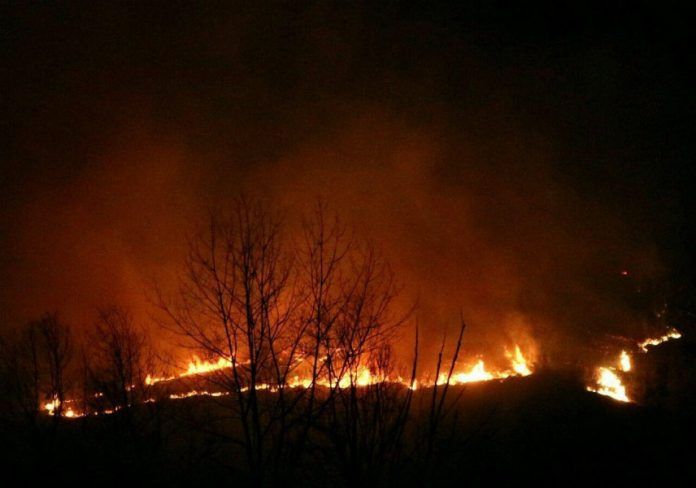Since early February, warm winds have fueled at least 62 wildfires that have burned 130 hectares of the Caspian Hyrcanian Mixed Forests — a UNESCO World Heritage Site — in the northern province of Gilan, according to Colonel Mohammad Ghorbani-Lord, the head of the nature reserve protection unit of the local Forest Range and Watershed Management Organization.
Colonel Ghorbani-Lord made the comments in an interview with the Iranian Students News Agency (ISNA) earlier this month.
“Unfortunately, fires started in 62 different places and damaged 130 hectares of forest area aided by warm winds,” Ghorbani-Lord said. “Fire has burned 30 hectares of forest in Rudbar Country, which is the hardest-hit county so far.”
“Close to 5,000 planted saplings, 200 sick trees and another 1,000 spread throughout the forest area in the county have been destroyed,” Ghorbani-Lord noted. “The segments of the Caspian Hyrcanian Mixed Forests that stretch through other counties in Gilan Province have suffered minor damages.”
A day earlier, the managing director of Gilan Province’s Forest Range and Watershed Management Organization, Mohsen Yousefpour, told the Tasnim news agency that wildfires initially affected 41 hectares of forest but spread quickly to an area of 130 hectares in eight counties of Talesh, Siahkal, Rezvanshahr, Masal, Astara, Fuman, Rasht and Rudbar.
“Warm winds helped to spread the fire through 16.5 hectares and 6 hectares of forest areas, respectively, in Talesh and Siahkal counties,” Mr. Yousefpour had said. “Also, 4 hectares and 6,000 square meters of forest areas were, respectively, burned in Rezvanshahr and Astara counties.”
In many areas, residents have joined the emergency and fire services, trying to put out the fires. There have been two wildfires that have threatened a large area of the Caspian Hyrcanian Mixed Forests in recent months. Although authorities have yet to determine the exact cause of these fires, some have attributed them to human activities.
“We will soon identify and prosecute those local farmers who intentionally burn forest areas to create larger grazing grasslands for their livestock,” the head of Astara’s Forest Range and Watershed Management Organization, Nasrin Ghaznavi, was quoted by Mehr News Agency as saying on December 26, 2019. “Unfortunately, warm winds fueled the fire and helped it to spread.”
[aesop_image img=”https://kayhanlife.com/wp-content/uploads/2019/07/هیرکانی-۰۰۱.jpg” panorama=”off” credit=”Hyrcanian forests. Source: Kayhan London” align=”center” lightbox=”off” captionsrc=”custom” captionposition=”left” revealfx=”off” overlay_revealfx=”off”]
In comments reported by Hamshahri newspaper on December 28, 2019, the head of Iran’s Supreme Forestry Council Kamran Pourmoghadam, said: “Wildfire and illegal logging are not the only threats to the Caspian Hyrcanian Mixed Forests. Trash and waste are also of significant concern. Cutting down saplings and other human activities pose a real threat to nature reserves.”
“We must draft specific plans for protecting the Caspian Hyrcanian Mixed Forests,” Mr. Pourmoghadam said. “We will roll out the ‘Forest Breathing’ project in 2 million hectares of the Caspian Hyrcanian Mixed Forests in 2020-21.”
The Hyrcanian forests stretch 850 kilometers along the southern coast of the Caspian Sea in Iran and the Republic of Azerbaijan. They cover parts of the five Iranian provinces of Northern Khorasan, Golestan, Mazandaran, Gilan, and Ardabil. The forests spread through an area of nearly 55,000 square kilometers.
The broad-leaved forests date back 25 to 50 million years. Almost 44 percent of vascular plants known in Iran grow in the Hyrcanian forests, which only cover 7 percent of the country. Wildlife conservationists have so far recorded 180 species of birds and 58 mammal species, including the Persian leopard, in the Hyrcanian forests.
The forest is in the ancient Hyrcanian region, which includes modern-day Gorgan, the capital of the northeastern province of Golestan. Europeans in centuries past who visited Gorgan called it Hyrcanian, which at one point included parts of the Semnan and Mazandaran provinces and the surrounding areas.
Inhabitants of the region permanently changed the name from Hyrcanian to Gorgan, which also covers the Gorgan Plain and Gorgan Gulf.
UNESCO designated the Caspian Hyrcanian Mixed Forests a World Heritage Sites in July 2019. The forests are the second natural reserve in Iran to be listed as a UNESCO World Heritage Site.
In July 2017, UNESCO added the Lut Desert (Dasht-e Lut), a vast salt desert in the southeastern provinces of Kerman and Sistan and Baluchestan, to its list.
[Translated from Persian by Fardine Hamidi]


